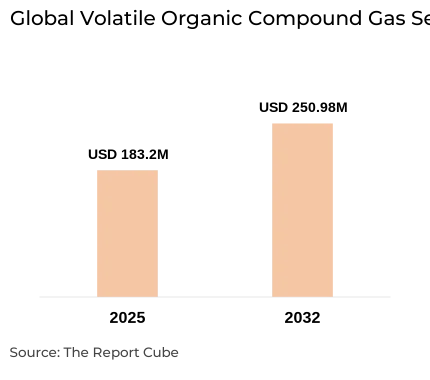
Understand The Key Trends Shaping This Market
Download Free SampleGlobal Volatile Organic Compound Gas Sensor Market Overview: Market Size & Forecast (2026–2032)
The Global Volatile Organic Compound Gas Sensor Market is projected to register a CAGR of around 4.6% during 2026–32, with its size valued at USD 183.2 million in 2025 and expected to reach USD 250.98 million by 2032. The surging consciousness about air pollution, occupational health, and industrial safety is a major aspect encouraging market growth. As governments reinforce regulations on what generates volatile organic compound (VOC) emissions in industrial settings, the necessity for VOC sensor technologies has increased across the automotive, oil & gas, and manufacturing industries.
Moreover, many innovations & partnerships shaped the VOC Gas Sensor Market. For example, Honeywell International Inc. introduced new connected VOC detectors for industrial safety, while Teledyne FLIR extended its optical gas imaging solutions for real-time VOC leak detection. Also, growing adoption of organic gas sensor technologies in smart cities & air quality monitoring programs is driving demand globally. Additionally, organizations are leveraging metal oxide semiconductor-based solutions & infrared-based detection systems for improved sensitivity & energy efficacy.
Furthermore, the Volatile Organic Compound Gas Sensor Market also profits from government initiatives aiming at environmental monitoring, workplace safety, and emission control standards. Also, nations across the Asia-Pacific & Europe are gradually embracing organic compound gas sensors for air quality monitoring & smart infrastructure. Further, looking ahead, market opportunities remain strong as IoT-enabled sensors, real-time monitoring systems, and modernizations in compound VOC gas sensor technology drive progression. Additionally, increasing expenditures in infrastructure for the detection of volatile organic compounds by 2032 would aid in achieving sustainability objectives & industrial compliance.
Global Volatile Organic Compound Gas Sensor Market Dynamics
-
Driver: Increasing Environmental & Industrial Safety Guidelines to Elevate Market Demand
One of the key drivers of the Volatile Organic Compound Gas Sensor Market is the rising demand for compliance with strict guidelines on air quality & industrial emissions. Governments across North America, Europe, and the Asia-Pacific have tightened environmental monitoring mandates to decrease volatile organic compound gas emissions in the oil & gas, chemical, and automotive industries. Moreover, these regulations encourage industries to employ organic compound sensor solutions for constant monitoring. Also, with rising awareness about the health impacts of volatile organic molecules, the acceptance of volatile gas sensor devices has increased.
-
Challenge: Higher Prices of Advanced VOC Detection Systems to Limit the Market
The higher initial costs & calibration necessities of modern infrared-based detection & photo-ionization detectors hamper their acceptance, despite the market's strong growth. Further, assimilating advanced organic compound VOC gas detection devices could be expensive for small- & medium-sized enterprises. Also, the technical restraints of sensors serve as complications, such as the need for regular maintenance & drift problems in metal oxide semiconductor-based detectors. Moreover, owing to these challenges, prevalent adoption might be decelerated, chiefly in developing nations where industrial finances are still constricted.

-
Opportunity: Incorporation with Smart Cities & IoT Platforms to Open New Avenues
The growing development of smart cities & IoT-enabled environmental systems presents a key opportunity for the Volatile Organic Compound Gas Sensor Industry. With governments & private enterprises investing in air quality monitoring, the incorporation of organic compound gas sensors with real-time data platforms is gaining momentum. Also, IoT-compatible VOC detectors are being deployed in public infrastructure, commercial spaces, and urban air quality networks. This expanding demand for digitalized & networked detection systems positions the industry for tremendous growth, mainly in APAC & Latin America.
-
Trend: Technical Advancements in Sensor Miniaturization & Sensitivity
A primary trend in the Volatile Organic Compound Gas Sensor Market is the transition toward smaller, energy-efficient, and highly sensitive detection systems. Market companies are emerging with metal oxide semiconductor technologies & enhancing infrared-based detection for more precise, real-time readings. Furthermore, these developments make volatile organic sensors progressively suitable for wearable tech, residential air quality monitoring, and automotive emission tracking. Also, the shift toward real-time VOC detection is likely to redesign the future of the market.
Volatile Organic Compound Gas Sensor Market Segmentation
By Technology:
- Photo-Ionization Detector (PID)
- Infrared-based Detection
- Metal-oxide Semiconductor
- Others
The Photo-Ionization Detector (PID) segment leads the VOC Gas Sensor Market, capturing a substantial market share in the succeeding years. This is owing to its great sensitivity & dependability in detecting low concentrations of volatile organic molecules. Furthermore, deployed in oil & gas, chemical, and environmental monitoring applications, PIDs offer accurate, real-time results. Also, their acceptance has been increasing worldwide due to surging industrial compliance needs & extensive usage in leak detection, occupational health monitoring, and hazardous environment safety programs.
By Application:
- Oil & Gas
- Agriculture
- Automotive
- Chemical Industry
- Manufacturing
- Food & Beverages
- Metals & Mining
- Others
The Oil & Gas sector is one of the foremost applications across the Volatile Organic Compound Gas Sensor Market, accounting for the largest market share. VOC detection is vital for ensuring operational safety, emission obedience, and environmental monitoring. Also, gas detection systems, like organic compound VOC gas sensors, are broadly utilized in drilling rigs, refineries, and petrochemical facilities. Further, with rising regulatory mandates & safety needs, oil & gas remains the major customer segment, substantially contributing to the Volatile Organic Compound Gas Sensor Market share.
Volatile Organic Compound Gas Sensor Industry Regional Insights
The Global Volatile Organic Compound Gas Sensor Market is geographically diversified, covering:
- North America
- Europe
- Asia-Pacific
- Latin America
- The Middle East & Africa
The Asia-Pacific region grabs the prominent share of the Global Volatile Organic Compound Gas Sensor Market. The regional dominance is driven by swift industrialization, increasing urban populations, and government-led air quality monitoring programs. Also, nations, including China, India, and Japan, are largely spending on organic gas sensors & compound VOC gas sensors for smart city projects & industrial wellbeing. Moreover, the region’s surging oil & gas exploration activities & solid acceptance of infrared-based detection technologies further improve its headship across the global market.
Volatile Organic Compound Gas Sensor Market: Recent Developments
2025:
- Figaro Engineering Inc. introduced a new range of miniaturized organic compound gas sensors enhanced for IoT-based air quality monitoring applications.
- Honeywell International Inc. launched an AI-powered volatile gas sensor system, tailored for real-time VOC detection in oil & gas facilities & industrial plants.
Key Takeaways of the Global Volatile Organic Compound Gas Sensor Market (2026–32)
- The Volatile Organic Compound Gas Sensor Market would expand at about 4.6% CAGR, attaining nearly USD 250.98 million by 2032.
- PIDs lead the technology division, while oil & gas leads applications.
- Asia-Pacific is the biggest regional market owing to industrial development & air quality initiatives.
- Major trends include IoT amalgamation, sensor miniaturization, and real-time detection.
- The market challenges include high system prices & calibration requirements in advanced detectors.
Global Volatile Organic Compound Gas Sensor Market: Conclusion & Future Outlook (2032)
By 2032, the Volatile Organic Compound Gas Sensor Market is destined to expand substantially, driven by strict environmental norms, increasing demand for real-time monitoring, and prevalent acceptance in smart cities. These developments are part of a broader trend in the global sensors market, which continues to evolve with innovations in IoT-enabled, multi-functional sensing solutions. For a comprehensive overview, see the Sensors Market Report.
What Does Our Global Volatile Organic Compound Gas Sensor Market Research Study Entail?
- The Global Volatile Organic Compound Gas Sensor Market Research Report highlights the forecast growth rate (CAGR) by anticipating the market size and share.
- The market analysis puts light upon the primary industry trends, driving aspects, potential opportunities, growth challenges, and other major factors.
- The Global Volatile Organic Compound Gas Sensor Market Research Report entails details about the most critical shifts in market share in the prominent regions.
- Considering the statistics & the developments by the primary market competitors, our report also strives to demonstrate the most sought-after strategies of the key players.
Table of Contents
- Introduction
- Objective of the study
- Product Definition
- Market Segmentation
- Study Variables
- Research Methodology
- Secondary Data Points
- Companies Interviewed
- Primary Data Points
- Break Down of Primary Interviews
- Secondary Data Points
- Executive Summary
- Market Dynamics
- Drivers
- Challenges
- Opportunity Assessment
- Recent Trends and Developments
- Policy and Regulatory Landscape
- Global Volatile Organic Compound Gas Sensor Market Overview (2020-2032)
- Market Size, By Value (in USD Millions)
- Market Share, By Technology
- Photo-Ionization Detector (PID)
- Infrared-based Detection
- Metal-oxide Semiconductor
- Others
- Market Share, By Type
- Single gas detection sensor
- Multiple gas detection sensor
- Market Share, By Application
- Oil & Gas
- Agriculture
- Automotive
- Chemical Industry
- Manufacturing
- Food & Beverages
- Metals & Mining
- Others
- Market Share, By Region
- North America
- Europe
- Asia-Pacific
- Latin America
- The Middle East & Africa
- Market Share, By Company
- Revenue Shares
- Competition Characteristics
- North America Volatile Organic Compound Gas Sensor Market Overview (2020-2032)
- Market Size, By Value (in USD Billions)
- Market Share, By Technology
- Market Share, By Type
- Market Share, By Application
- By Country
- The US
- Canada
- Mexico
- The US Volatile Organic Compound Gas Sensor Market Overview (2020-2032)
- Market Share, By Technology
- Market Share, By Type
- Market Share, By Application
- Canada Volatile Organic Compound Gas Sensor Market Overview (2020-2032)
- Market Share, By Technology
- Market Share, By Type
- Market Share, By Application
- Mexico Volatile Organic Compound Gas Sensor Market Overview (2020-2032)
- Market Share, By Technology
- Market Share, By Type
- Market Share, By Application
- South America Volatile Organic Compound Gas Sensor Market Overview (2020-2032)
- Market Size, By Value (in USD Billions)
- Market Share, By Technology
- Market Share, By Type
- Market Share, By Application
- By Country
- Brazil
- Argentina
- Rest of South America
- Brazil Volatile Organic Compound Gas Sensor Market Overview (2020-2032)
- Market Share, By Technology
- Market Share, By Type
- Market Share, By Application
- Argentina Volatile Organic Compound Gas Sensor Market Overview (2020-2032)
- Market Share, By Technology
- Market Share, By Type
- Market Share, By Application
- Europe Volatile Organic Compound Gas Sensor Market Overview (2020-2032)
- Market Size, By Value (in USD Billions)
- By Technology
- By Type
- By Application
- By Country
- Germany
- The UK
- France
- Spain
- Italy
- Rest of Europe
- Germany Volatile Organic Compound Gas Sensor Market Overview (2020-2032)
- Market Share, By Technology
- Market Share, By Type
- Market Share, By Application
- France Volatile Organic Compound Gas Sensor Market Overview (2020-2032)
- Market Share, By Technology
- Market Share, By Type
- Market Share, By Application
- The UK Volatile Organic Compound Gas Sensor Market Overview (2020-2032)
- Market Share, By Technology
- Market Share, By Type
- Market Share, By Application
- Spain Volatile Organic Compound Gas Sensor Market Overview (2020-2032)
- Market Share, By Technology
- Market Share, By Type
- Market Share, By Application
- Italy Volatile Organic Compound Gas Sensor Market Overview (2020-2032)
- Market Share, By Technology
- Market Share, By Type
- Market Share, By Application
- The Middle East & Africa Volatile Organic Compound Gas Sensor Market Overview (2020-2032)
- Market Size, By Value (in USD Billions)
- By Technology
- By Type
- By Application
- By Country
- The UAE
- Saudi Arabia
- South Africa
- Rest of the Middle East & Africa
- The UAE Volatile Organic Compound Gas Sensor Market Overview (2020-2032)
- Market Share, By Technology
- Market Share, By Type
- Market Share, By Application
- Saudi Arabia Volatile Organic Compound Gas Sensor Market Overview (2020-2032)
- Market Share, By Technology
- Market Share, By Type
- Market Share, By Application
- South Africa Volatile Organic Compound Gas Sensor Market Overview (2020-2032)
- Market Share, By Technology
- Market Share, By Type
- Market Share, By Application
- Asia-Pacific Volatile Organic Compound Gas Sensor Market Overview (2020-2032)
- Market Size, By Value (in USD Billions)
- By Technology
- By Type
- By Application
- By Country
- China
- India
- Japan
- South Korea
- Australia
- Rest of Asia-Pacific
- China Volatile Organic Compound Gas Sensor Market Overview (2020-2032)
- Market Share, By Technology
- Market Share, By Type
- Market Share, By Application
- India Volatile Organic Compound Gas Sensor Market Overview (2020-2032)
- Market Share, By Technology
- Market Share, By Type
- Market Share, By Application
- Japan Volatile Organic Compound Gas Sensor Market Overview (2020-2032)
- Market Share, By Technology
- Market Share, By Type
- Market Share, By Application
- South Korea Volatile Organic Compound Gas Sensor Market Overview (2020-2032)
- Market Share, By Technology
- Market Share, By Type
- Market Share, By Application
- Austraila Volatile Organic Compound Gas Sensor Market Overview (2020-2032)
- Market Share, By Technology
- Market Share, By Type
- Market Share, By Application
- Competitive Outlook (Company Profile - Partila List)
- Figaro Engineering Inc.
- Company Overview
- Business Segments
- Strategic Alliances/Partnerships
- Recent Developments
- AMS AG
- Company Overview
- Business Segments
- Strategic Alliances/Partnerships
- Recent Developments
- Honeywell International Inc.
- Company Overview
- Business Segments
- Strategic Alliances/Partnerships
- Recent Developments
- Siemens AG
- Company Overview
- Business Segments
- Strategic Alliances/Partnerships
- Recent Developments
- Teledyne FLIR LLC
- Company Overview
- Business Segments
- Strategic Alliances/Partnerships
- Recent Developments
- Aeroqual Limited
- Company Overview
- Business Segments
- Strategic Alliances/Partnerships
- Recent Developments
- Alphasense Ltd
- Company Overview
- Business Segments
- Strategic Alliances/Partnerships
- Recent Developments
- Drägerwerk AG & Co. KGaA
- Company Overview
- Business Segments
- Strategic Alliances/Partnerships
- Recent Developments
- Global Detection Systems Corp.
- Company Overview
- Business Segments
- Strategic Alliances/Partnerships
- Recent Developments
- Others
- Figaro Engineering Inc.
- Disclaimer
List of Figure
Figure 1: Market Size of Global Volatile Organic Compound (VOC) Gas Sensor Market (2020–2032)
Figure 2: Global VOC Gas Sensor Market Share by Technology
Figure 3: Market Share of Photo-Ionization Detector (PID) Technology
Figure 4: Market Share of Infrared-based Detection Technology
Figure 5: Market Share of Metal-Oxide Semiconductor Technology
Figure 6: Market Share of Other Technologies
Figure 7: Global VOC Gas Sensor Market Share by Type
Figure 8: Market Share of Single Gas Detection Sensors
Figure 9: Market Share of Multiple Gas Detection Sensors
Figure 10: Global VOC Gas Sensor Market Share by Application
Figure 11: Application-wise Market Share: Oil & Gas
Figure 12: Application-wise Market Share: Agriculture
Figure 13: Application-wise Market Share: Automotive
Figure 14: Application-wise Market Share: Chemical Industry
Figure 15: Application-wise Market Share: Manufacturing
Figure 16: Application-wise Market Share: Food & Beverages
Figure 17: Application-wise Market Share: Metals & Mining
Figure 18: Application-wise Market Share: Others
Figure 19: Global VOC Gas Sensor Market Share by Region
Figure 20: Market Share by Company – Revenue Shares
Figure 21: Competitive Landscape – Key Characteristics
Figure 22: North America VOC Gas Sensor Market Size (2020–2032)
Figure 23: North America Market Share by Technology
Figure 24: North America Market Share by Type
Figure 25: North America Market Share by Application
Figure 26: U.S. VOC Gas Sensor Market Overview – Market Share by Technology
Figure 27: Canada VOC Gas Sensor Market Overview – Market Share by Type
Figure 28: Mexico VOC Gas Sensor Market Overview – Market Share by Application
Figure 29: South America VOC Gas Sensor Market Size
Figure 30: South America Market Share by Technology
Figure 31: South America Market Share by Type
Figure 32: South America Market Share by Application
Figure 33: Brazil VOC Gas Sensor Market Share by Technology
Figure 34: Argentina VOC Gas Sensor Market Share by Type
Figure 35: Europe VOC Gas Sensor Market Size
Figure 36: European Market Share by Technology
Figure 37: European Market Share by Type
Figure 38: European Market Share by Application
Figure 39: Germany VOC Gas Sensor Market Overview
Figure 40: France VOC Gas Sensor Market Overview
Figure 41: UK VOC Gas Sensor Market Overview
Figure 42: Spain VOC Gas Sensor Market Overview
Figure 43: Italy VOC Gas Sensor Market Overview
Figure 44: Middle East & Africa VOC Gas Sensor Market Size
Figure 45: Market Share by Technology in MEA
Figure 46: Market Share by Type in MEA
Figure 47: Market Share by Application in MEA
Figure 48: UAE VOC Gas Sensor Market Overview
Figure 49: Saudi Arabia VOC Gas Sensor Market Overview
Figure 50: South Africa VOC Gas Sensor Market Overview
Figure 51: Asia-Pacific VOC Gas Sensor Market Size
Figure 52: Asia-Pacific Market Share by Technology
Figure 53: Asia-Pacific Market Share by Type
Figure 54: Asia-Pacific Market Share by Application
Figure 55: China VOC Gas Sensor Market Overview
Figure 56: India VOC Gas Sensor Market Overview
Figure 57: Japan VOC Gas Sensor Market Overview
Figure 58: South Korea VOC Gas Sensor Market Overview
Figure 59: Australia VOC Gas Sensor Market Overview
Figure 60: Competitive Outlook: Figaro Engineering Inc. – Business Segments & Strategic Alliances
Figure 61: AMS AG – Company Overview & Recent Developments
Figure 62: Honeywell International Inc. – Strategic Partnerships
Figure 63: Siemens AG – Market Position & Developments
Figure 64: Teledyne FLIR LLC – Key Business Segments
Figure 65: Aeroqual Limited – Strategic Alliances & Recent Activities
Figure 66: Alphasense Ltd – Product Portfolio & Partnerships
Figure 67: Drägerwerk AG & Co. KGaA – Market Insights
Figure 68: Global Detection Systems Corp. – Recent Developments
List of Table
Table 1: Objective of the Study
Table 2: Product Definition of VOC Gas Sensors
Table 3: Market Segmentation Criteria
Table 4: Study Variables
Table 5: Research Methodology Overview
Table 6: Secondary Data Points
Table 7: Companies Interviewed
Table 8: Primary Data Points
Table 9: Break Down of Primary Interviews
Table 10: Executive Summary – Key Market Metrics
Table 11: Drivers of VOC Gas Sensor Market
Table 12: Challenges in VOC Gas Sensor Market
Table 13: Opportunity Assessment
Table 14: Recent Trends and Developments
Table 15: Policy and Regulatory Landscape
Table 16: Global VOC Gas Sensor Market Size (2020–2032)
Table 17: Market Size by Value (USD Millions)
Table 18: Market Share by Technology
Table 19: Market Share by Type
Table 20: Market Share by Application
Table 21: Market Share by Region
Table 22: Market Share by Company
Table 23: North America Market Size and Forecast
Table 24: Market Share by Technology – North America
Table 25: Market Share by Type – North America
Table 26: Market Share by Application – North America
Table 27: Market Size by Country – US, Canada, Mexico
Table 28: South America Market Size and Forecast
Table 29: Market Share by Technology – South America
Table 30: Market Share by Type – South America
Table 31: Market Share by Application – South America
Table 32: Market Size by Country – Brazil, Argentina, Rest of South America
Table 33: Europe Market Size and Forecast
Table 34: Market Share by Technology – Europe
Table 35: Market Share by Type – Europe
Table 36: Market Share by Application – Europe
Table 37: Market Size by Country – Germany, France, UK, Spain, Italy, Rest of Europe
Table 38: Middle East & Africa Market Size and Forecast
Table 39: Market Share by Technology – MEA
Table 40: Market Share by Type – MEA
Table 41: Market Share by Application – MEA
Table 42: Market Size by Country – UAE, Saudi Arabia, South Africa, Rest of MEA
Table 43: Asia-Pacific Market Size and Forecast
Table 44: Market Share by Technology – Asia-Pacific
Table 45: Market Share by Type – Asia-Pacific
Table 46: Market Share by Application – Asia-Pacific
Table 47: Market Size by Country – China, India, Japan, South Korea, Australia, Rest of Asia-Pacific
Table 48: Competitive Outlook – Company Profiles Summary
Table 49: Figaro Engineering Inc. – Company Overview & Strategic Alliances
Table 50: AMS AG – Business Segments & Recent Developments
Table 51: Honeywell International Inc. – Strategic Partnerships
Table 52: Siemens AG – Key Developments
Table 53: Teledyne FLIR LLC – Business Segments & Alliances
Table 54: Aeroqual Limited – Strategic Partnerships & Developments
Table 55: Alphasense Ltd – Product Portfolio & Partnerships
Table 56: Drägerwerk AG & Co. KGaA – Market Overview
Table 57: Global Detection Systems Corp. – Company Profile Summary
Top Key Players & Market Share Outlook
- Figaro Engineering Inc.
- AMS AG
- Honeywell International Inc.
- Siemens AG
- Teledyne FLIR LLC
- Aeroqual Limited
- Alphasense Ltd
- Drägerwerk AG & Co. KGaA
- Global Detection Systems Corp.
- Others
Frequently Asked Questions








